CITROEN C-ELYSÉE 2018 Handbook (in English)
Manufacturer: CITROEN, Model Year: 2018, Model line: C-ELYSÉE, Model: CITROEN C-ELYSÉE 2018Pages: 260, PDF Size: 8.4 MB
Page 1 of 260
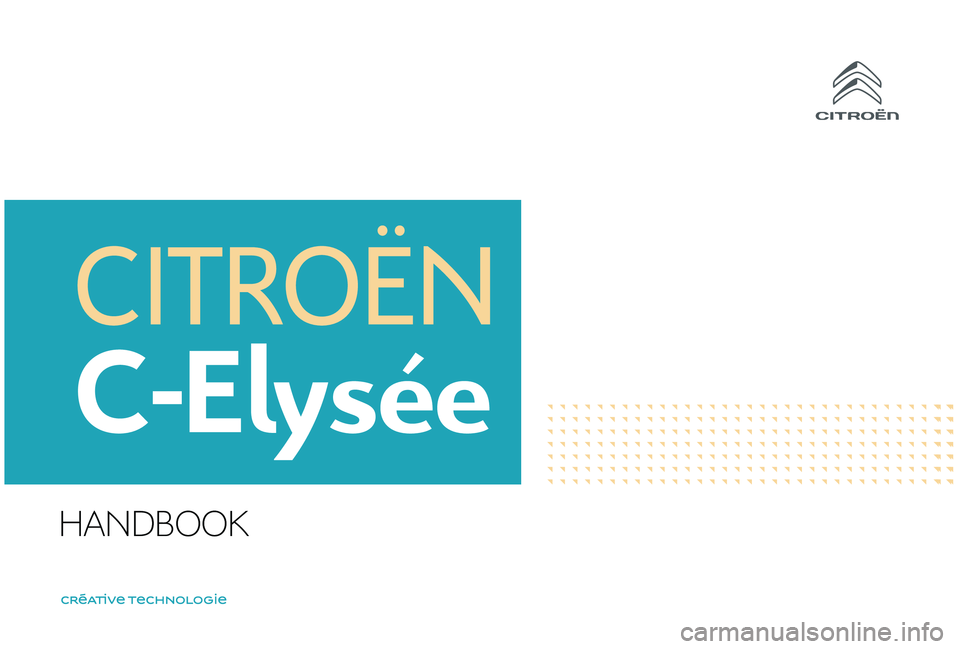
HANDBOOK
Page 2 of 260
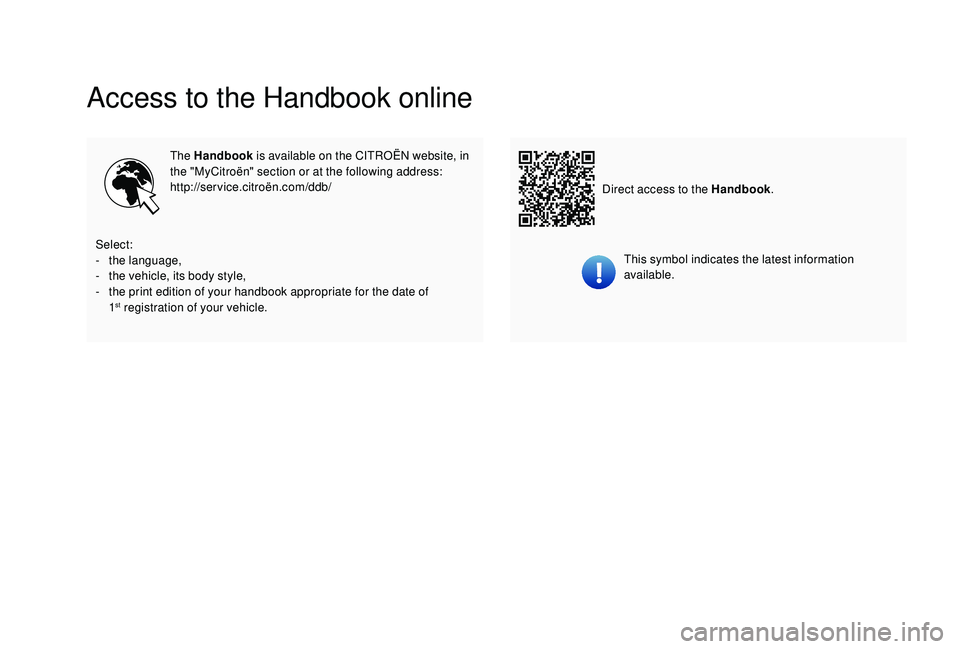
Access to the Handbook online
The Handbook is available on the CITROËN website, in
the "MyCitroën" section or at the following address:
http://service.citroën.com/ddb/
This symbol indicates the latest information
available.
Direct access to the Handbook
.
Select:
- t
he language,
-
t
he vehicle, its body style,
-
t
he print edition of your handbook appropriate for the date of
1
st registration of your vehicle.
Page 3 of 260
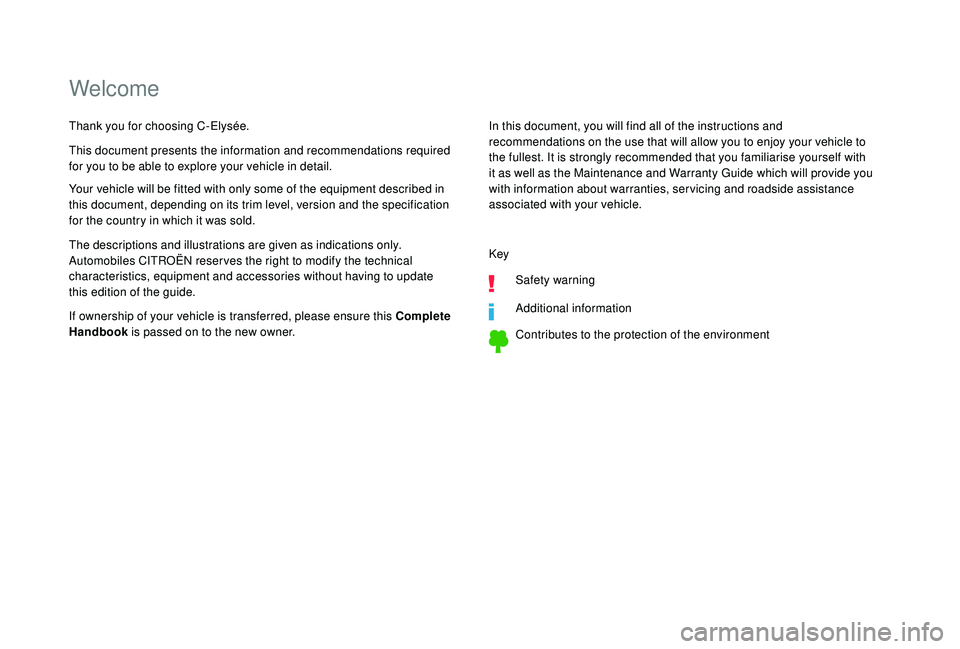
Welcome
In this document, you will find all of the instructions and
recommendations on the use that will allow you to enjoy your vehicle to
the fullest. It is strongly recommended that you familiarise yourself with
it as well as the Maintenance and Warranty Guide which will provide you
with information about warranties, servicing and roadside assistance
associated with your vehicle.
Thank you for choosing C-Elysée.
This document presents the information and recommendations required
for you to be able to explore your vehicle in detail.
Your vehicle will be fitted with only some of the equipment described in
this document, depending on its trim level, version and the specification
for the country in which it was sold.
The descriptions and illustrations are given as indications only.
Automobiles CITROËN reser ves the right to modify the technical
characteristics, equipment and accessories without having to update
this edition of the guide.
If ownership of your vehicle is transferred, please ensure this Complete
Handbook
is passed on to the new owner. Key
Safety warning
Additional information
Contributes to the protection of the environment
Page 4 of 260

2
.
.
Instrument Panel 8
W arning and indicator lamps 9
I
ndicators
19
Distance recorders
2
4
Setting the date and time
2
4
Trip computer
2
6Remote control
2
9
Alarm
32
Doors
33
Boot
34
Window controls
3
6
Front seats 3 7
Rear bench seat 3 9
Steering wheel adjustment 4
0
Mirrors
4
0
Heating
4
1
Manual air conditioning
(without display screen)
4
2
Electronic air conditioning
(with display screen)
4
4
Front demist – defrost
4
5
Rear screen demist – defrost
4
6
Fittings
4
8Lighting control
5
1
Direction indicators
5
3
Headlamp adjustment
5
4
Wiper control stalk
5
4
Courtesy lamps
5
5
General safety recommendations
5
7
Hazard warning lamps
5
8
Horn 58
Emergency or assistance call 5 8
Electronic stability control (ESC)
6
0
Seat belts
6
2
Airbags
65
Child seats
6
8
Deactivating the passenger's front airbag
7
0
ISOFIX mountings
7
5
Child lock
7
9
Over view
Instruments Access
Ease of use and comfort Safety
Lighting and visibility
Eco-driving
Eco-driving 6
Contents
Page 5 of 260
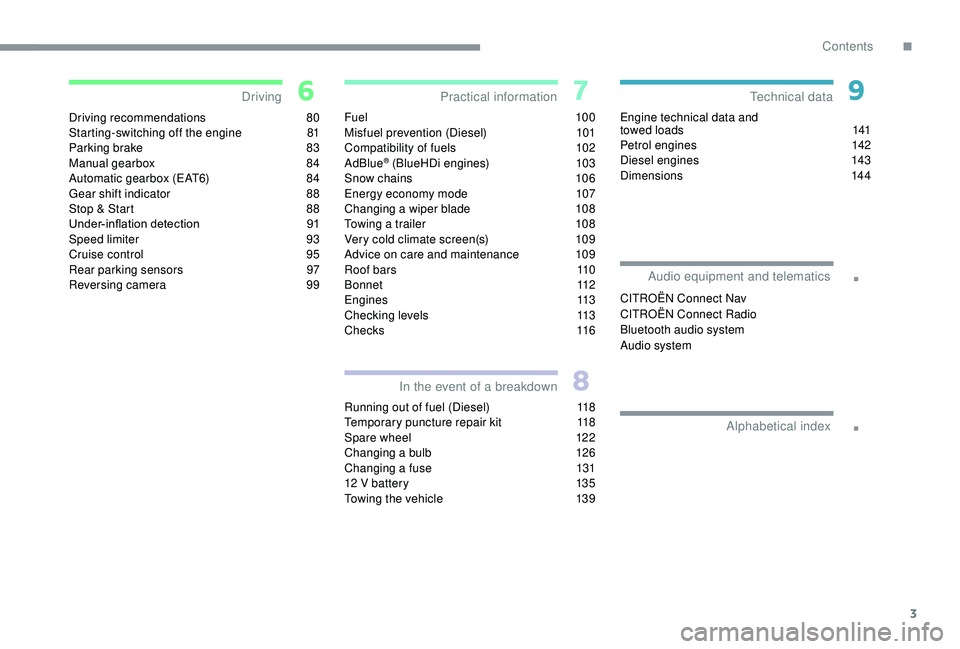
3
.
.
Driving recommendations 80
Starting-switching off the engine 8 1
Parking brake
8
3
Manual gearbox
8
4
Automatic gearbox (EAT6)
8
4
Gear shift indicator
8
8
Stop & Start
8
8
Under-inflation detection
9
1
Speed limiter
9
3
Cruise control
9
5
Rear parking sensors
9
7
Reversing camera
9
9Fuel 1
0 0
Misfuel prevention (Diesel) 1 01
Compatibility of fuels
1
02
AdBlue
® (BlueHDi engines) 1 03
Snow chains 1 06
Energy economy mode
1
07
Changing a wiper blade
1
08
Towing a trailer
1
08
Very cold climate screen(s)
1
09
Advice on care and maintenance
1
09
Roof bars
1
10
B o n n e t
112
Engines
1
13
Checking levels
1
13
C h e c k s
11
6
Running out of fuel (Diesel)
1
18
Temporary puncture repair kit
1
18
Spare wheel
1
22
Changing a bulb
1
26
Changing a fuse
1
31
12
V battery
1
35
Towing the vehicle
1
39Engine technical data and
towed loads
1
41
Petrol engines
1
42
Diesel engines 1 43
Dimensions 144
DrivingPractical information
In the event of a breakdown Technical data
Alphabetical index
Audio equipment and telematics
CITROËN Connect Nav
CITROËN Connect Radio
Bluetooth audio system
Audio system
.
Contents
Page 6 of 260
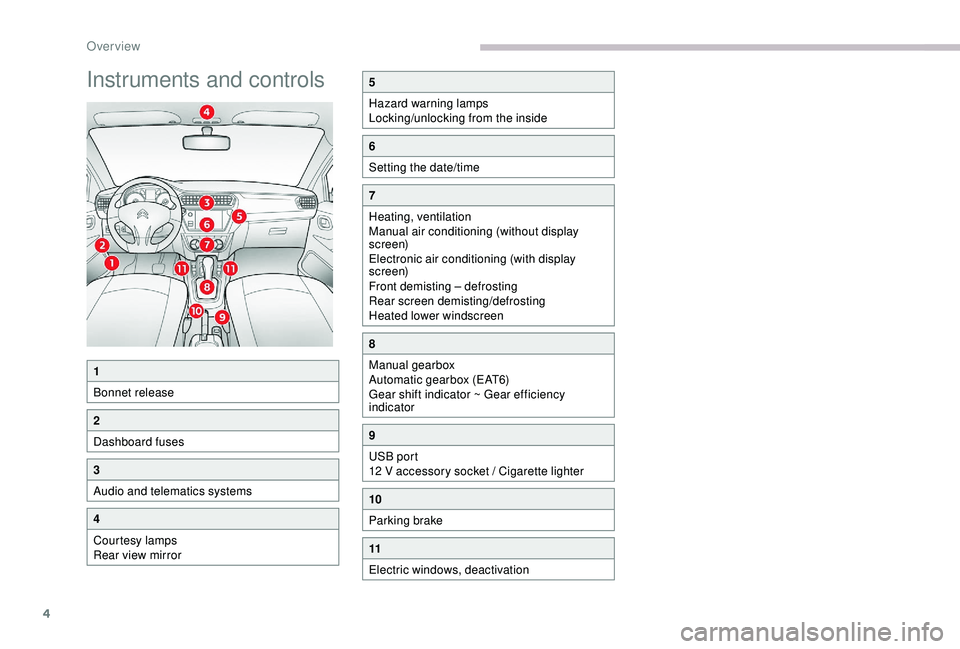
4
Instruments and controls5
Hazard warning lamps
Locking/unlocking from the inside
6
Setting the date/time
7
Heating, ventilation
Manual air conditioning (without display
screen)
Electronic air conditioning (with display
screen)
Front demisting – defrosting
Rear screen demisting/defrosting
Heated lower windscreen
8
Manual gearbox
Automatic gearbox (EAT6)
Gear shift indicator ~ Gear efficiency
indicator
9
USB port
12 V accessory socket / Cigarette lighter
10
Parking brake
11
Electric windows, deactivation
1
Bonnet release
2
Dashboard fuses
3
Audio and telematics systems
4
Courtesy lamps
Rear view mirror
Over view
Page 7 of 260
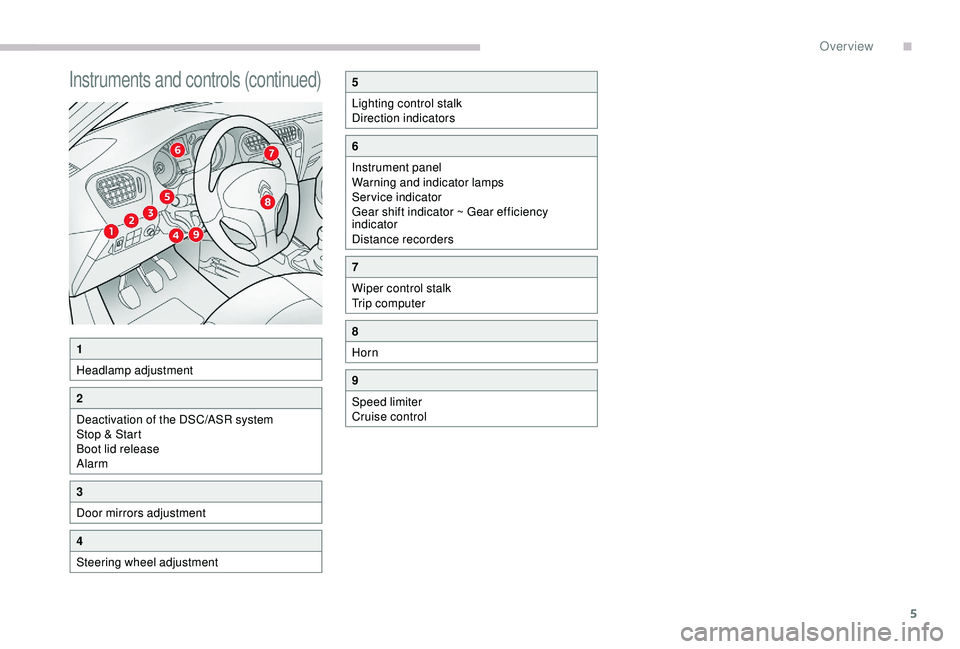
5
Instruments and controls (continued)
1
Headlamp adjustment
2
Deactivation of the DSC/ASR system
Stop & Start
Boot lid release
Alarm
3
Door mirrors adjustment
4
Steering wheel adjustment
5
Lighting control stalk
Direction indicators
6
Instrument panel
Warning and indicator lamps
Service indicator
Gear shift indicator ~ Gear efficiency
indicator
Distance recorders
7
Wiper control stalk
Trip computer
8
Horn
9
Speed limiter
Cruise control
.
Over view
Page 8 of 260
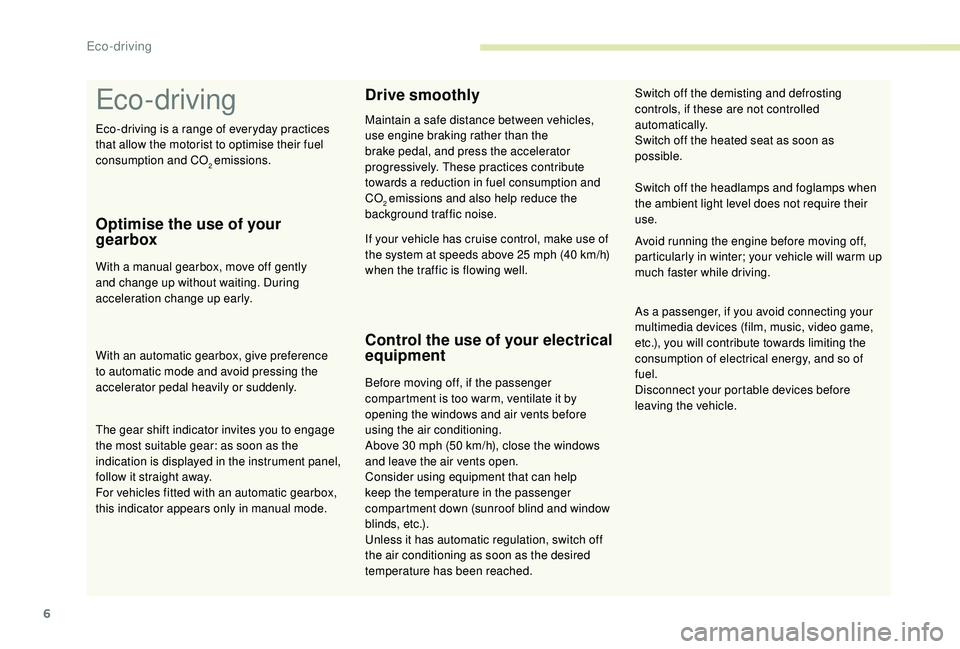
6
Eco- driving
Optimise the use of your
gearbox
With a manual gearbox, move off gently
and change up without waiting. During
acceleration change up early.
With an automatic gearbox, give preference
to automatic mode and avoid pressing the
accelerator pedal heavily or suddenly.
Drive smoothly
Maintain a safe distance between vehicles,
use engine braking rather than the
brake pedal, and press the accelerator
progressively. These practices contribute
towards a reduction in fuel consumption and
CO
2 emissions and also help reduce the
background traffic noise.
Control the use of your electrical
equipment
Before moving off, if the passenger
compartment is too warm, ventilate it by
opening the windows and air vents before
using the air conditioning.
Above 30
mph (50 km/h), close the windows
and leave the air vents open.
Consider using equipment that can help
keep the temperature in the passenger
compartment down (sunroof blind and window
blinds, etc.).
Unless it has automatic regulation, switch off
the air conditioning as soon as the desired
temperature has been reached. Switch off the headlamps and foglamps when
the ambient light level does not require their
use.
Avoid running the engine before moving off,
particularly in winter; your vehicle will warm up
much faster while driving.
As a passenger, if you avoid connecting your
multimedia devices (film, music, video game,
etc.), you will contribute towards limiting the
consumption of electrical energy, and so of
fuel.
Disconnect your portable devices before
leaving the vehicle.
The gear shift indicator invites you to engage
the most suitable gear: as soon as the
indication is displayed in the instrument panel,
follow it straight away.
For vehicles fitted with an automatic gearbox,
this indicator appears only in manual mode. If your vehicle has cruise control, make use of
the system at speeds above 25
mph (40 km/h)
when the traffic is flowing well. Switch off the demisting and defrosting
controls, if these are not controlled
automatically.
Switch off the heated seat as soon as
possible.
Eco-driving is a range of everyday practices
that allow the motorist to optimise their fuel
consumption and CO
2 emissions.
Eco-driving
Page 9 of 260

7
Limit the causes of excess
consumption
Spread loads throughout the vehicle; place
the heaviest items in the bottom of the boot,
as close as possible to the rear seats.
Limit the loads carried in the vehicle and
reduce wind resistance (roof bars, roof rack,
bicycle carrier, trailer, etc.). Use a roof box in
preference.
Remove roof bars and roof racks after use.
At the end of winter, remove snow tyres and
refit your summer tyres.
Observe the recommendations
on maintenance
Check the tyre pressures regularly, when cold,
referring to the label in the door aperture,
driver's side.
Carry out this check in particular:
-
b
efore a long journey,
-
a
t each change of season,
-
a
fter a long period out of use. Have your vehicle ser viced regularly (engine
oil, oil filter, air filter, passenger compartment
filter, etc.) and obser ve the schedule of
operations in the manufacturer's service
schedule. Don't forget the spare wheel and the tyres on
any trailer or caravan.
With a BlueHDi diesel engine, if the SCR
system is faulty, your vehicle becomes
polluting. Visit a CITROËN or a qualified
workshop as soon as possible to bring your
vehicle’s nitrogen oxide emissions back in line
with regulations.
When filling the tank, do not continue after the
3
rd cut-off of the nozzle to avoid over flow.
At the wheel of your new vehicle, it is only
after the first 1,800
miles (3,000 kilometres)
that you will see the fuel consumption settle
down to a consistent average.
.
Eco-driving
Page 10 of 260

8
Instrument panel
Rev counter
Rev counter (x 1,000 rpm).
Display screen
AAutomatic gearbox information.
Gear shift indicator.
B Time.
C Range related to the fuel or the AdBlue
®
and the SCR system (miles or km).
or
Trip distance recorder.
D Fuel gauge / Diesel preheater.
E Ser vice indicator (miles or km)
then,
Odometer.
These two functions are displayed
successively when switching on the
ignition.
F Cruise control or speed limiter settings.
Speedometer
Speedometer (mph or km/h).
Control button
- Momentary information reminder:
• o n servicing,
•
o
n the remaining driving range with the
emissions fluid (AdBlue
®).
-
R
esetting of the selected function to zero
(trip distance recorder or ser vice indicator).
-
S
etting the time.
Instruments